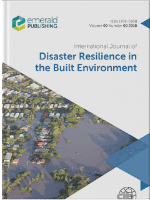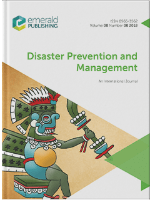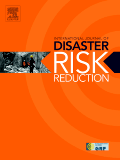
International Journal of Disaster Resilience in the Built Environment
Scope & Guideline
Cultivating knowledge for a resilient built environment.
Introduction
Aims and Scopes
- Disaster Risk Assessment and Management:
The journal explores methodologies for assessing disaster risks and developing comprehensive management strategies to mitigate these risks in the built environment. - Resilient Infrastructure Development:
Research focuses on designing and retrofitting infrastructure to withstand disasters, including studies on building materials, construction techniques, and urban planning. - Stakeholder Engagement and Community Resilience:
It emphasizes the role of various stakeholders, including government, communities, and NGOs, in fostering resilience through participatory approaches. - Climate Change Adaptation:
The journal publishes studies on adapting built environments to the impacts of climate change, including rising sea levels, extreme weather events, and urban heat islands. - Nature-Based Solutions:
Research on integrating natural systems and solutions into urban planning and disaster resilience strategies is highlighted, promoting sustainability and ecological balance. - Policy and Governance Frameworks:
The journal addresses the need for coherent policies and governance structures that support disaster resilience and sustainable development goals.
Trending and Emerging
- Smart Technologies and Disaster Management:
The integration of smart technologies, such as IoT and AI, in disaster risk reduction and management is gaining traction, reflecting the need for data-driven and efficient solutions. - Nature-Based Solutions for Urban Resilience:
There is an increasing focus on nature-based solutions, recognizing their potential to enhance urban resilience through sustainable practices and ecological restoration. - Climate Resilient Agriculture:
Research is trending towards developing agricultural practices that are resilient to climate change, emphasizing the interconnection between food security and disaster resilience. - Community-Led Resilience Initiatives:
There is a growing emphasis on community participation and leadership in resilience-building initiatives, recognizing that local knowledge and engagement are crucial for effective disaster management. - Health Infrastructure Resilience:
The resilience of health infrastructure, particularly in the context of pandemics and natural disasters, is emerging as a significant area of research, highlighting the interconnectedness of health and disaster risk management.
Declining or Waning
- Historical Disaster Studies:
Research focusing on historical disaster events and their impacts has seen a decline, as the journal shifts towards contemporary issues and future resilience strategies. - Traditional Construction Methods:
There is a waning interest in studies solely centered on traditional construction methods, as more emphasis is placed on innovative and sustainable building practices. - Single-Hazard Focus:
The journal has moved away from studies that focus solely on single hazards (e.g., earthquakes or floods) to a more integrated approach that considers multiple hazards and their interactions. - Post-Disaster Recovery:
While still relevant, research specifically focused on post-disaster recovery processes has decreased in favor of proactive resilience-building strategies. - Local Case Studies:
The emphasis on localized case studies has diminished, with more research being directed towards broader, comparative analyses that can inform global practices.
Similar Journals

Disaster Prevention and Management
Exploring multidisciplinary strategies for disaster management.Disaster Prevention and Management, published by Emerald Group Publishing Ltd, is a leading journal in the fields of disaster management, public health, and environmental policy. With an ISSN of 0965-3562 and an E-ISSN of 1758-6100, this journal has made significant contributions to both theoretical and practical advancements since its inception in 1992. Operating from the United Kingdom, it holds a Q2 ranking across various categories, including Business, Management and Accounting, Health (Social Science), and Public Health, reflecting its pivotal role in academic discourse and policy formulation. By engaging with contemporary issues related to disaster risk reduction, emergency preparedness, and resilience strategies, Disaster Prevention and Management aims to foster a multidisciplinary approach, making it a vital resource for researchers, practitioners, and students seeking to navigate the complexities of disaster scenarios effectively. With an impressive Scopus ranking across multiple categories, researchers are encouraged to explore its diverse range of articles and reports available for their academic and professional endeavors.

International Journal of Disaster Risk Reduction
Elevating standards in disaster risk management and safety research.The International Journal of Disaster Risk Reduction is a leading academic publication dedicated to advancing the understanding and management of disaster risks, promoting innovative solutions and effective strategies for risk reduction. Published by ELSEVIER, this journal serves as a critical platform for researchers, professionals, and students in the fields of Geology, Geotechnical Engineering, and Safety Research. With an impressive impact factor and ranked in the top quartile (Q1) across its various categories as of 2023, it demonstrates exceptional quality and relevance in its contributions to science and engineering disciplines. The journal has been committed to disseminating high-quality research since its inception in 2012 and remains open for new submissions through 2024. The Scopus rankings reflect its prestigious position, with notable placements in Earth and Planetary Sciences and Social Sciences, highlighting its influence in shaping best practices for disaster risk governance. As an essential resource for anyone involved in disaster preparedness and mitigation, the International Journal of Disaster Risk Reduction fosters knowledge exchange and collaboration among stakeholders in the global community.

Journal of Regional and City Planning
Navigating the complexities of urban growth and change.Journal of Regional and City Planning, published by ITB JOURNAL PUBL, is a pivotal platform dedicated to advancing research in the fields of urban studies, geography, and development. Established in Indonesia, this esteemed journal (ISSN: 2502-6429) serves as an integrative forum for scholars, professionals, and students to explore the complex dynamics of regional and city planning within the context of rapidly changing urban environments. With a commendable Scopus ranking that places it in the Q3 category for Development and Geography and Q2 for Urban Studies, the journal emphasizes quality scholarship aimed at informing policy and practice between 2017 and 2024. Although currently not available in open access, it maintains a solid reputation for its rigorous peer-reviewed articles that contribute significantly to the academic discourse and practical frameworks in urban and regional development. Its commitment to fostering dialogue on sustainable development makes it a vital resource for anyone involved in planning and policy-making.

Urbe-Revista Brasileira de Gestao Urbana
Navigating the Complexities of Urban Life TogetherUrbe-Revista Brasileira de Gestão Urbana is a prominent academic journal dedicated to the field of urban management and development, published by the esteemed Pontificia Universidade Catolica do Paraná (PUCPR). This open-access journal, actively disseminating knowledge since 2009, focuses on advancing awareness and understanding of urban planning, architecture, and geographical issues in Brazil and beyond. With an impressive impact reflected in its 2023 quartile rankings—Q2 in Architecture, Q3 in Geography, Planning and Development, and Q3 in Urban Studies—Urbe serves as a vital platform for researchers and professionals alike. The journal strives to foster interdisciplinary dialogue and provide valuable insights into contemporary urban challenges, making it an essential resource for those engaged in the study and practice of urban management. Scholars can access it freely, enhancing its reach and relevance in an increasingly interconnected world.

NATURAL HAZARDS
Driving research to mitigate the impacts of natural disasters.NATURAL HAZARDS is a premier academic journal published by SPRINGER that focuses on the multidimensional aspects of natural hazards, their impacts, and mitigation strategies. With a robust impact factor and esteemed rankings in reputable databases such as Scopus, this journal is classified in the Q2 category in Atmospheric Science and Q1 in both Earth and Planetary Sciences (miscellaneous) and Water Science and Technology, showcasing its influence in these critical fields. Established in 1988 and continuing through 2024, it serves as a vital resource for researchers, professionals, and students alike, providing cutting-edge research and insights into the dynamics of natural hazards. Although it does not offer open-access options, the journal is accessible through institutional subscriptions, ensuring that high-quality research is disseminated efficiently to those dedicated to advancing our understanding of environmental challenges. By publishing empirical studies, theoretical analyses, and case studies, NATURAL HAZARDS plays a crucial role in informing disaster management policies and strategies, thereby contributing to a safer, more resilient world.

Jamba-Journal of Disaster Risk Studies
Bridging Theory and Practice in Disaster Management.Jamba-Journal of Disaster Risk Studies, published by AOSIS, serves as a vital resource in the fields of management, monitoring, policy, law, and safety research, with an ISSN of 1996-1421 and an E-ISSN of 2072-845X. Since its establishment as an Open Access journal in 2006, Jamba has dedicated itself to disseminating high-quality research that informs and enhances disaster risk management practices, particularly within the South African context and beyond. With a robust Impact Factor and acknowledgement in the Q2 and Q3 quartiles across critical categories in 2023, Jamba ranks favorably in Scopus, notably Rank #50/109 in Social Sciences (Safety Research) and Rank #218/399 in Environmental Science (Management, Monitoring, Policy and Law). The journal's convergence over the years—from 2013 to 2024—signals its commitment to adapting contemporary challenges in disaster risk studies. Scholars and practitioners are encouraged to explore Jamba as a go-to platform for innovative insights and collaborative discussions that impact policy-making and practical applications in disaster risk reduction.

Smart Cities
Shaping Tomorrow's Cities with Cutting-Edge InsightsSmart Cities is an esteemed academic journal published by MDPI, dedicated to the interdisciplinary exploration of urban innovation through advanced technologies, particularly in the realms of Artificial Intelligence, Electrical and Electronic Engineering, and Urban Studies. Since its inception in 2018, the journal has established itself as a prominent source of cutting-edge research, maintaining a commendable ranking within the top quartile (Q1) across its focus areas. With an impressive impact factor reflective of its influence—ranked 6th out of 279 in Urban Studies and within the top 15% in related engineering and computer science fields—the journal ensures accessibility to its content through an Open Access model, enabling researchers, professionals, and students from around the globe to engage with and contribute to the ongoing dialogue about the future of smart urban environments. Situated in Switzerland, the journal is positioned at the nexus of innovation and urban development, making it an indispensable resource for those seeking to advance knowledge and applications in smart city initiatives.

Progress in Disaster Science
Transforming Knowledge into Action for Disaster ManagementProgress in Disaster Science, published by ELSEVIER, is a prestigious open-access journal that has been advancing the field of disaster research since its inception in 2019. With an ISSN of 2590-0617, the journal has quickly established itself as a leading resource, recognized for its impact across various related disciplines, as evidenced by its impressive Q1 rankings in 2023 in categories such as Earth and Planetary Sciences, Environmental Science, Geography, Planning and Development, and Safety Research. This journal publishes cutting-edge research that aims to enhance understanding and management of disaster risks, resilience, and recovery processes. Additionally, the journal's accessibility ensures that important findings are disseminated widely, fostering collaboration among researchers, professionals, and students globally. Positioned under the umbrella of critical environmental and safety insights, Progress in Disaster Science plays a pivotal role in shaping the discourse surrounding disaster management and preparedness in today's rapidly changing world.

Urban Water Journal
Innovating Research for Resilient Urban Water SystemsUrban Water Journal, published by TAYLOR & FRANCIS LTD, stands as an essential resource in the fields of Geography, Planning and Development and Water Science and Technology, reflecting its strong academic rigor and substantial contributions to urban water management and research since its inception in 2004. With an impressive impact factor indicated by its Q2 ranking in both disciplines, this journal serves as a vital platform for researchers, practitioners, and policymakers to disseminate and access pioneering studies and innovations related to urban water systems. The journal's focus extends to various aspects of urban water usage, sustainability, and policy-making, ensuring that readers are equipped with the latest findings that address pressing global challenges. Located in the United Kingdom, Urban Water Journal is committed to advancing knowledge in urban water resilience and sustainability, making it a crucial publication for those engaged in this dynamic and critical field. For researchers and professionals dedicated to impactful solutions in urban water management, this journal offers a comprehensive venue for sharing insights and fostering collaboration.

Frontiers in Built Environment
Shaping tomorrow's cities with impactful research today.Frontiers in Built Environment, published by FRONTIERS MEDIA SA, is a highly regarded open-access journal that has established itself as a significant platform for cutting-edge research in the fields of building and construction, geography, planning and development, and urban studies. Since its inception in 2015, this journal has embraced a commitment to disseminating high-quality, peer-reviewed research, allowing researchers, professionals, and students to access pivotal findings and insights without financial barriers. With an impressive 2023 impact factor, it ranks in the Q1 tier for Urban Studies and is positioned within the Q2 tier for both Building and Construction and Geography, Planning and Development, demonstrating its influence and relevance in evolving urban and environmental challenges. Its rigorous indexing, exemplified by a strong Scopus ranking, reflects its contribution to the advancement of knowledge in these critical areas. With a clear dedication to fostering innovation and collaboration within the built environment sector, Frontiers in Built Environment is essential reading for those engaged in shaping sustainable urban futures.